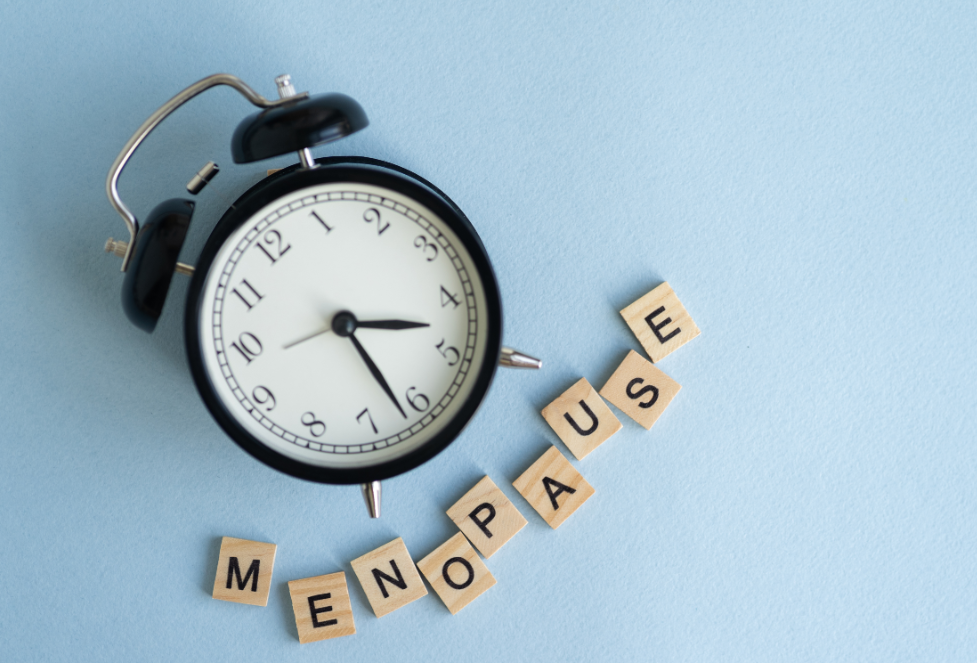Casting a spotlight on middle age, new data exposes a disconcerting reality - millions of British women over the age of 40 still remain in the dark about the myriad of symptoms that accompany menopause and perimenopause.
A study of over 1000 women in the UK, who are perimenopausal or experiencing the menopause, found that they can only name an average of FOUR symptoms - a mere fraction of the 48 that can accompany the onset of those going through this transitional period. While just 6% of women believe they can name ten.
Hot flushes [87%], night sweats [85%], and emotional mood swings [76%] are the three most commonly known symptoms, according to the study commissioned by sleep technology firm Simba.
But far fewer respondents are aware of lesser-known indications that are all side effects of midlife hormonal changes, such as dizziness, panic attacks, dental problems and itchy, crawly skin - despite over one in six [16%] grappling with this skin sensation daily.
Only a quarter [26%] of those who battle xerostomia (dry mouth) and knotted muscles and tension at least once a month know this to be because of the menopause and perimenopause. While just 30% of those afflicted with gastrointestinal problems & nausea know their condition to be a symptom.
The research lays bare that 6 million women could be silently navigating a spectrum of physical and emotional shifts.
According to Simba’s findings, over a quarter [28%] of women who are perimenopausal or experiencing the menopause grapple each month with over 20 symptoms monthly, from mental wellbeing, skin mouth and eye problems to physical wellbeing.
Of those surveyed, over half [56%] are unaware that some of the symptoms they suffer with are linked to the perimenopause - the transitional phase before the menopause, which can begin in women in their early 40s.
Simba, makers of innovative Stratos® temperature-regulating technology to bring cool and comfortable sleep to all, is a Founding Partner of GenM, the menopause partner for brands that works to empower companies to understand and cater to menopausal consumers and employees.
Recognising the pivotal role that mattresses, pillows, duvets, and sleep accessories play in enhancing sleep quality, sleep tech innovator Simba now displays the M-Tick – the world’s first recognisable menopause-friendly symbol.
Similar to the vegan V or gluten-free labelling, the M-tick was launched by GenM to make it easy for consumers to find products that support the 48 menopause symptoms, providing them with a wealth of choice to take control of their menopause in the way that best suits them.
Sam Simister, co-founder of GenM said: “The findings in Simba’s study tally with the research that we have conducted at GenM. In fact, our data reveals further that – despite an increase in discussions on the topic – women’s lived experience with menopause is not improving and women are becoming more anxious about it rather than less.
“This shows that we need more responsible brands like Simba to play their part in improving both awareness of symptoms and access to support and solutions.”
GenM recognises 48 medical, credible and clinical symptoms of the menopause, and the study also found that sleep disturbances [21.2%], hot flushes [21%] fatigue [19%], night sweats [17%] and weight gain [16%] are the five most crippling of symptoms.
With 39% of women suffering from sleep disturbances daily.
Menopause occurs as a result of hormonal shifts, particularly a decrease in oestrogen and progesterone production within the ovaries.
These two vital sex hormones play intricate roles in a myriad of functions affecting sleep patterns, appetite regulation, emotional well-being, and overall quality of life.
Lisa Artis, deputy CEO at sleep tech firm Simba’s charity partner, The Sleep Charity said: “Oestrogen oversees the processing of neurotransmitters such as serotonin, which plays a key role in regulating the sleep-wake cycle.
“This hormone also influences nighttime body temperature, contributing to enhanced sleep quality and even possessing natural antidepressant properties.
“However, when a woman's oestrogen production tapers off, she may encounter elevated body temperatures (leading to hot flushes), emotional fluctuations, and a decline in sleep quality.
“‘Menopause-related insomnia can stretch on for weeks and months, if not properly treated, so it’s really important to take the decline in sleep quality seriously.”
Pairing innovation and indulgence, the Simba Hybrid® Luxe features eleven layers of refined and data-driven design and incorporates state of the art technology. Excelling in climate control, each layer in the sumptuous mattress works cohesively to promote airflow and cooling comfort - providing the most sought-after slumber yet.
Simba has also extended its expertise to a range of thoughtfully crafted sleep essentials that benefit from Stratos® temperature-regulating technology, including the Simba’s Hybrid Duvet, hailed as ‘the menopause miracle’ and the Simba Stratos® Pillow.
This advanced Stratos® temperature control tech supports menopausal and perimenopausal women by creating a cool-touch surface and actively transfers heat away from the body, maintaining the comfort of the sleeper.
There are around 15.5 million menopausal women in the UK at any one time and global figures are estimated to hit 1 billion by the year 2025. Yet, most feel entirely overlooked and underserved at home, at work and across society.
Sam Simister concludes: “We need to make it easy for those in menopause to find goods and services to ease, support and relieve the 48 symptoms, so they can take control of their menopause in the way that best suits them. We’re delighted to be working with Simba to implement the M-Tick – our world-first menopause-friendly symbol – in their range of products.”

Do you know your Menopause A-Z?
Just as learning the alphabet paved the way for effective communication as a child, getting to grips with the A-Z of menopause symptoms empowers women in mid-life to recognize and address changes in their bodies, promoting better physical and mental well-being.
A
-
(1) ANXIETY
Ever feel like you're buzzing with tension, as if you're plugged into a live wire? It's there when you wake up and follows you around all day, making small things harder to shake off. You just want to let go of the worries and get back to feeling like yourself again. A major hint is when your mind goes into overdrive over everyday stuff – things that normally wouldn't bother you now drive you crazy. Plus, the thought of going out or hanging with friends loses its appeal, and you'd rather cosy up solo at home.
B
-
(2) BREAKOUTS
Skin breakouts, akin to puberty's turmoil, stem from hormonal shifts. As oestrogen wanes, androgens persist, agitating oil glands, causing acne by clogging follicles. Hormone therapy, despite replacing oestrogen, floods the body with progestin, unsettling the skin. Unlike adolescent acne on T-zone, menopausal acne emerges along cheeks and jawline.
You might also find you have spots now when you didn’t have them when you were young. Dermatologists are finding that instances of acne in older women have been increasing for the last 10-20 years, with women often battling with breakouts for the first time as they reach middle-age.
-
(3) BLADDER WEAKNESS
Whether it’s a few drops here and there, or a full-on accident, if you are battling with leaks, you’re not the only one. Urinary incontinence affects millions of women ‘of a certain age’. Hormonal changes (especially oestrogen going AWOL) can thin the lining of the urethra, the tube that takes pee from the bladder and out of your body. Your surrounding stomach and pelvic muscles can also be affected by hormonal changes and cause your bladder to change position.
-
(4) BRAIN FOG
As oestrogen levels fluctuate and decline, it can affect neurotransmitters, brain structure, and blood flow, leading to cognitive symptoms like forgetfulness, difficulty concentrating, and mental cloudiness often referred to as brain fog.
-
(5) BREATHING DIFFICULTIES
While not as widespread as other symptoms, a minority of women may encounter breathing difficulties during menopause. This symptom can manifest in various ways.
For some, a heightened shortness of breath emerges, while others grapple with diminished exercise capacity and fatigue. Menopause can also exacerbate pre-existing lung conditions, like asthma or chronic obstructive airway disease, potentially worsening them. Though the exact mechanisms behind breathing difficulties during menopause are not fully grasped, a dip in oestrogen could impact body inflammation, potentially influencing lung function.
C
-
(6) CHANGES IN BREAST SIZE
As oestrogen reduces, breasts enter 'involution,' a phase where milk glands call it quits and fat steps in.
-
(7) CHANGES IN SEX DRIVE
Has your sex drive made a swift exit, leaving no forwarding address? Blame it on the dwindling hormone levels, wreaking havoc not just on our bodies but also in our minds. And let's face it, for most women, a satisfying sex life demands a harmonious mind-body duo.
-
(8) CHANGES IN SKIN TEXTURE
As oestrogen levels decline, so does the precious skin-plumping collagen, initiating this process during perimenopause. Collagen, constituting 75% of your skin, forms a crucial scaffold within the dermis, maintaining its firmness and elasticity.In menopause, studies reveal an initial 30% reduction in collagen over the first five years, followed by a gradual 2% decrease each year for the subsequent two decades.
Aging brings about dryness and a natural reduction in fatty tissue, leading to less firmness in your jawline, cheeks, and neck. This transition is marked by the appearance of crow's feet and lines around your upper lip.
D
-
(9) DIZZINESS
Many women report feeling off-balance as their bodies start changing. As for the reasons behind dizziness during menopause? Well, the honest answer is that nobody has a precise answer right now.
-
(10) DENTAL PROBLEMS (dry mouth, bleeding and receding gums)
As your oestrogen levels decline, your entire body, including your mouth, becomes drier. Unfortunately, bacteria can thrive in this dry setting, leading to tooth decay, as well as bleeding or receding gums.
-
(11) DECREASING FERTILITY
Every woman’s reproductive timeline is different. Ovulation becomes more erratic as we age – so it can be hard to plot. The amount of follicle-stimulating hormone (FSH) produced by your brain increases as your number of eggs falls. But it’s tricky to get accurate blood or urine test results, as levels of this hormone also fluctuate as you go through perimenopause.
-
(12) DEPRESSION
It's not just a case of feeling down. It's as if the joy of life has drained away. As oestrogen levels decrease, these brain chemicals can become imbalanced, potentially leading to mood disturbances and an increased vulnerability to depression.
If you’re coping with disrupted sleep, hot flushes, and anxiety just to name a few as well, it’s easy to see how you might slip into a very low mood. Because our hormones are fluctuating so erratically, some medical professionals believe the risk of depression increases because of this.
E
-
(13) EYE DRYNESS
One of the less talked-about menopause symptoms is dry eyes, affecting approximately 10% of women undergoing this phase. This issue arises from inadequate tear production or ineffective tears. Our eyes are coated and kept moist by a tear film composed of a complex mix of water, oil, and mucus. When this film is lacking, the eyes can feel gritty, as if there's something inside. This can lead to sensations of stinging, burning, blurred vision, and irritation. While dry eyes are a common aspect of ageing, their intensity can heighten during menopause due to reduced oestrogen and androgens (male hormones present in all women).
-
(14) EMOTIONAL SWINGS (MOOD SWINGS)
Feel like you're riding an emotional rollercoaster, with unpredictable highs and lows that seem to defy explanation? You’re not alone. Oestrogen works its magic, nudging us into high spirits and signalling the production of serotonin, another mood enhancer, but as your ovaries gradually ease up on the oestrogen and progesterone output, your emotional state can take a rollercoaster ride each time your body adapts to these hormone level changes.
That's why you might notice yourself getting irked more than usual for a week or two, followed by smoother emotional sailing for about a month. Perimenopause-induced bursts of fury have their own distinct flavour – they can ambush you out of thin air, turning tranquillity into boiling frustration in the blink of an eye.
F
-
(15) FEELING COLD
As oestrogen levels decrease, the hypothalamus may become less effective in controlling temperature, leading to sensations of coldness, especially in response to minor temperature changes. Additionally, changes in blood circulation and metabolism that occur during menopause can also contribute to feeling chilly.
-
(16) FIERY MOUTH
Oestrogen plays a role even in your saliva, influencing the bitter taste buds at the back of your tongue. Unfortunately, these buds are surrounded by an unhelpful gang of pain receptors. Experts suggest that decreasing oestrogen levels during perimenopause might cause damage to these taste buds, resulting in uncomfortable sensations, ranging from dryness to metallic tastes and even fiery mouth pain.
-
(17) FATIGUE
Fatigue is a very common symptom. It's that horrible feeling where you have no energy - and for no evident reason - and it’s caused by hormone imbalances.
G
-
(18) GASTROINTESTINAL PROBLEMS & NAUSEA
Does nausea make an appearance during menopause and perimenopause? Absolutely. Do we have the full scoop on why? Unfortunately, not quite.
Here's the deal: it's more likely to show up during perimenopause, especially in the AM. One idea floating around is that lower progesterone levels can kick off a party of gastrointestinal woes – bloating, heartburn, and indigestion, all having their say in the nausea game.
Perimenopausal and menopausal tag-alongs like fatigue and anxiety can also throw their hats in the ring, causing some serious tummy turmoil. Stress in the brain? That's like pressing a turbo for your gut. Now, let's add a little more fuel to the fire. Low oestrogen waves the flag for cortisol, the stress hormone, and adrenaline, the fight-or-flight MVP. This dynamic duo could be behind the scenes, twisting your digestive function into knots.
And as you shimmy from perimenopause to menopause, nausea might shuffle offstage, replaced by gusty winds, constipation, and a stomachache. No, it's not the most glamorous forecast, but consider us your weather guides through the storm.
H
-
(19) HEADACHES AND MIGRAINES
Perhaps you're no stranger to the occasional headache during your monthly cycle. But if they have taken a turn for the worse lately, it can be part of the menopause mix. As our bodies navigate the perimenopause, the hormonal duo of progesterone and oestrogen, which regulate our cycles, play an energetic game of yo-yo. These fluctuations can amplify the intensity of headaches and migraines, leaving you feeling dizzy and nauseated. The silver lining is that this phase won't last forever. As you transition from perimenopause into menopause, most women find themselves dealing with fewer and less severe headaches.
-
(20) HEART PALPITATIONS
It can strike out of the blue – skipped beats, extra beats, and a heart that's suddenly racing. Or perhaps you've become acutely conscious of your heartbeat in a manner you've never been before? The ebb and flow of oestrogen and progesterone levels can cast a ripple effect on numerous bodily functions during perimenopause and menopause – including your cardiovascular system.
-
(21) HOT FLUSHES
The “poster child” symptom of the menopause. Whether it sneaks up on you or builds gradually, the sensation is unmistakable: an intense wave of heat, akin to being placed right beneath a sunbed. Typically, these hot flushes retreat within four minutes, yet some dash away in mere seconds, while others linger for up to ten minutes.
In addition to a flushed complexion that engulfs your face, neck, and chest, you might notice warm skin and upper body perspiration. This fiery episode might even give your heart an irregular dance and leave your fingertips tingling. Toss night sweats and changes in blood pressure into the mix, and you've got a less-than-enjoyable combo.
Severity varies based on the individual and where you stand in your menopausal journey. While a considerable 75% of women experience hot flushes, some might hardly notice a few per week, while others might endure several sweaty rounds each hour.
I
-
(22) IRREGULAR PERIODS
For years, your periods might have been as dependable as clockwork or a tad offbeat but still within reason. Yet now, your body seems to have chucked the schedule right out the window. Your once predictable "time of the month" has become a wild card. When it does decide to show up, it could be an all-out event or a mere blip on the radar. So, what's behind these capricious periods?
You guessed it – those hormones are at it again. Imbalances in oestrogen and progesterone are the culprits behind the irregular and unpredictable nature of these cycles. They could be lighter, heavier, more frequent, or more spaced out than you're used to.
-
(23) IRRITABILITY
Irritability – we all get it, and it's part of the package. Yet, thanks to the menopause, you might notice it's cranking up the volume, hitting the pedal, and going from zero to sixty in a flash.
Remember the days when a mere eye-roll was enough for that mug left astray or that turtle-paced cashpoint user? Well, now, you're feeling like you're about to erupt like a volcano. According to Simba’s survey, 22% of women weathering the perimenopause or menopause experience irritability daily.
As oestrogen takes its leave, it leaves a trail of not-so-pleasant side effects in its wake, with irritability, stress, anxiety, and memory glitches making their grand entrance. It's like those hormones are staging a rebellion, even loosening your grip on the emotional volume dial.
-
(24) ITCHY CRAWLY SKIN
The official term for this peculiar phenomenon is 'pruritus.' It often sneaks onto the scene during perimenopause and might even linger as you officially cross the menopause threshold. Oestrogen is the maestro behind collagen production, the skin's essential building block. It’s also the mastermind behind the skin's natural oils, those VIPs that keep your skin well-hydrated.
So, when oestrogen decides to take a little vacation, your skin might start feeling like a dry, thin, and itchy desert. Most women find this sensation throwing a party on their neck, chest, and back, but honestly, it's an equal-opportunity phenomenon that can grace any part of your body.
J
-
(25) JOINT PAIN
Ever wake up feeling like the Tin Man, needing a WD40 spritz to get moving? That morning stiffness you're grappling with might not be an age thing – it could be waving the perimenopause or menopause banner. Oestrogen seems to have a hand in kicking off those musculoskeletal aches and pains that come knocking during menopause. It messes with your cartilage, that crucial connector in your joints, and even tampers with the natural bone replacement show going on in your body. Cue inflammation and pain. And don't forget the fluid balance dance.
Now, here's the not-so-fun part. As perimenopause waltzes in, hormonal somersaults lead to joints that hold less water – basically what they need to function smoothly. Low oestrogen might even be drumming up some low-grade inflammation, adding another layer to that menopause joint pain you're feeling.
If you're wondering why mornings seem like a wrestling match with discomfort, you're not alone. Many women find that symptoms are fiercer in the AM, only to ease up as the day rolls on. And as for the favoured joints for this dance? Well, there's no set rule – they're just having their own unpredictable party.
K
-
(26) KNOTTED MUSCLES & TENSION
Are you waking up in the night feeling stiff and sore? Everything feels tight but you can’t sleep properly because you’re in pain. It’s a vicious circle. Menopause and muscle pain are linked. Muscle aches are caused by seesawing oestrogen and progesterone, as their levels wobble about and then drop off.
Progesterone has a calming effect on the body and mind, so when this starts to pop off everything gets tenser. This can go hand in hand with feeling more anxious. Low oestrogen then opens the gateway for high levels of cortisol, the stress hormone that raises blood pressure and blood sugar. Shed loads of cortisol and scrappy amounts of oestrogen cause your muscles to tighten and get tired. At the same time, women lose muscle mass after they hit 40. Female stem cells rely on oestrogen to repair and rebuild tissue, so as this hormone disappears, so do they.
L
-
(27) LOSS OF BONE DENSITY
Osteoporosis, literally meaning 'porous bones' in Greek, has a sneaky way of tiptoeing into the picture. This trouble brews over the years, often making its grand entrance only when a minor accident leads to a fracture. Oestrogen is like the superhero hormone of bone health, and its decline can lead to trouble.
-
(28) LOSS OF SELF CONFIDENCE
Just like many other menopause symptoms, dwindling confidence can often be attributed to the decrease in oestrogen and possibly testosterone levels. However, it's not a solo act – life's events, shifts in family dynamics, relationship twists, and workplace matters can also step into the spotlight. Aging's physical changes may also play a part. The thing is, these factors could have a direct or indirect connection to the menopause journey.
M
-
(29) MEMORY LOSS & LOSS OF CONCENTRATION
This symptom tends to pop up for most women in the initial stages of perimenopause. Typically, it arrives like waves as they navigate towards menopause (and sometimes even beyond), rather than sticking around like an unwelcome guest. While it's not set in stone, many believe hormonal roller coasters might be the culprit. Hormones and brain neurotransmitters have quite the partnership. When hormone levels hit a low note, it can cast a shadow over brain function.
N
-
(30) NAIL CHANGES
Remember the days when you never gave your nails a second thought? Fast forward to now, and things have taken a twist. Your nails have gone all dry and flaky, and when they grow, they feel like they're ready to pull a bendy straw act. They've lost their mojo.
Blame it on the perimenopause parade. As hormone levels waltz southward, various body parts decide to join the chaotic dance – nails included. Your nails? They're like warriors made of keratin, a tough protein. But when perimenopause and menopause crash the party, falling oestrogen levels decide to play the spoiler, weakening the keratin and leaving your nails less robust.
And, oh, let's not forget oestrogen's role as the hydration police. With it taking a step back, dehydration becomes a sneaky contender. Say hello to flaky nails, unwelcome headaches, and skin changes as its tag-along companions.
-
(31) NIGHT SWEATS
If bedtime has turned into a soggy mess instead of a sultry affair, blame it on the night sweats. Picture this: a duvet flipping frenzy, waking up drenched and sticky in a room that should feel cool. You're not alone. 23% of perimenopausal and menopausal women experience these nocturnal hot flushes every night.
As your oestrogen levels play hopscotch, your hypothalamus (the brain's temperature regulator) goes a bit haywire. It mistakes you for a walking sauna, triggering your built-in sprinkler system – the sweat glands.
Look to invest in a mattress engineered for cool comfort - pairing innovation and indulgence, the Simba Hybrid® Luxe features eleven layers of refined and data-driven design and incorporates state of the art technology. Excelling in climate control, each layer in the sumptuous mattress works cohesively to promote airflow and cooling comfort - providing the most sought-after slumber yet.
O
-
(32) OVERWHELMING LEVELS OF PMS
When extreme PMS kicks in, it's often the early warning signal of something significant brewing within. As perimenopause rolls in, the hormone progesterone decides to play a wild game of rollercoaster, even while periods are still on the scene. The hunch is that these roller coaster rides are to blame for women facing a turbocharged edition of their usual premenstrual symptoms.
-
(33) OLFACTORY & TASTE CHANGES
Heightened or altered sense of smell and taste can be an unusual symptom. Suddenly finding your daily coffee unappealing?
Perhaps your beloved scented candle has taken an odd turn in aroma? Think of it as a buddy system: our oestrogen levels and saliva are connected. So, when menopause comes around and oestrogen takes a backseat, some women might find themselves with less saliva flowing from their salivary glands. Saliva has a job – breaking down food into distinct chemicals that our taste buds interpret as various flavours. But if you're dealing with reduced saliva and a parched mouth, your taste sensation might take a hit or even throw you a flavour curveball.
P
-
(34) PUFFINESS & BLOATING
Bloating during menopause often points a finger at the hormone duo, oestrogen and progesterone, engaged in their complex dance. As the body navigates perimenopause and menopause, these hormonal shifts can contribute to bloating. Additionally, lifestyle factors like diet, exercise, and sensitivities to specific foods or allergies can also play a role in bloating during this phase of life.
-
(35) PANIC ATTACKS
Panic attacks during menopause are often influenced by a combination of hormonal fluctuations, neurotransmitter imbalances, increased stress levels, sleep disturbances, and psychological factors.
The hormonal shifts, particularly the decline in oestrogen, can disrupt the delicate balance of neurotransmitters like serotonin and GABA, which play a crucial role in regulating mood and anxiety. The physical symptoms, emotional adjustments, and the perception of losing control associated with menopause can amplify stress, potentially triggering panic attacks. Sleep disruptions common in menopause can further exacerbate vulnerability to anxiety-related episodes.
Q
-
(36) QUICKER TO FORGET
Wait, what was her name? And what on earth were you talking about just now? Oh, and when's that appointment again? Seriously, where did your phone vanish off to? Dealing with forgetfulness is like dealing with a stubborn puzzle piece – it's exasperating. But don't sweat it, because you're not alone on this memory rollercoaster.
Why the memory hiccup during perimenopause? Well, it's like a brain fog takeover, making recollecting freshly-learned tidbits a real challenge.
R
-
(37) RANDOM BODY SENSATIONS
It might feel like a sudden, sharp jolt through your whole body, a pinching, static shock or random pains flicking on and off. Some women say they feel these across their forehead just before a hot flush. These strange sensations aren’t fully understood but it’s thought to be to do with the brain misfiring neurons because of hormone imbalances.
Oestrogen plays a role in our nervous system (the extent to which is not known yet either). So as levels drop during the menopause, this may cause mixed messages between your brain and body, resulting in weird pains when nothing is actually the matter.
S
-
(38) SLEEP ISSUES & INSOMNIA
Entering perimenopause, sleep takes a hit. Blame it on the nose diving oestrogen levels. Turns out, oestrogen is our sleep's BFF, optimising serotonin and other sleepy chemicals. Now, as you stride through perimenopause and onward to menopause, sleep's not the only thing acting up. Say hello to partners in crime: night sweats and anxiety. Great, right? Not exactly the dream team for a restful slumber.
In an effort to make quality restorative sleep more accessible, the Simba Stratos Pillow offers a premium sleep experience at a budget-friendly price. Featuring Simba’s cooling Stratos® temperature technology, this next-generation pillow offers cool-touch tech to prevent sticky, sweaty nights. The pillow has a cool, sleep side treated with the advanced Stratos technology that feels fresh to the touch while helping to draw heat away from your body so you always stay at the perfect temp.
-
(39) SAGGING BREASTS
Right before we go from the perimenopause into the menopause, our oestrogen levels drop dramatically. This fall causes our reproductive systems, including our ability to produce milk, to start shutting down, and the glandular tissue in our breasts shrinks as a result.
This change, combined with depleting collagen production due to the ageing process, can cause your breasts to sag.
The nipples may downturn, stretch marks can appear and you might notice that they look further apart than before. This is all very normal and a common side-effect that many women experience.
-
(40) SORE BREASTS
It’s common for women to feel their breasts ache ahead of their period, however, during the menopause, this heavy, aching feeling can strike at any point. The changes in oestrogen and progesterone result in breast pain feeling more intense than in the run up to a period - with some women saying they experience a stabbing or burning pain.
T
-
(41) THINNING HAIR
Lower levels of oestrogen can lead to your hair feeling brittle and your scalp dry. While decreasing levels of progesterone affect hair growth. As we move through the perimenopause and menopause, not only can the rate of growth slow down, but your hair may also grow thinner.
Most people lose around 100 hairs a day – this is a perfectly normal part of the hair lifecycle. However, these hormonal changes can also lead to some women finding they shed a lot more.
A change in the balance of hormones during the menopause transition can mean that the androgens become more important. For some women this triggers hair loss - hair thinning. Genetic factors can also be important for some women, meaning you may be 'programmed' to lose hair.
-
(42) TINGLING EXTREMITIES
We have all experienced that seemingly random feeling of pins and needles, but many might not realise this is also a symptom of the menopause. It’s medically referred to as ‘paresthesis’, and is generally believed to be due to fluctuating oestrogen levels.
U
-
(43) UNUSUAL & UNPLEASANT BODY ODOUR
You stand to fix a drink, but an unpleasant odour hits you. Do your underarms seem oddly funky? Wasn't BO supposed to bid farewell after our teens? Is it making a bold return now?
Entering perimenopause, dwindling oestrogen kicks our hypothalamus (the temp-regulating brain part) into high gear, prompting extra sweat production. And when we sweat, proteins become a feast for bacteria - resulting in the smell.
As we move from the perimenopause into the menopause, you may actually find your sense of smell becomes heightened – which might lead you to think you’re stinking out your workmates when actually you’re not.
V
-
(44) VAGINAL DRYNESS
Vaginal dryness during menopause is primarily attributed to the decline in oestrogen levels. Oestrogen helps maintain the vaginal lining, lubrication, and overall tissue health. As oestrogen decreases, the vaginal walls can become thinner, less elastic, and produce less natural lubrication, leading to discomfort, irritation, and dryness.
W
-
(45) WEIGHT GAIN
Despite not changing your eating habits, your clothes are feeling snug and weight has crept on - especially around the middle. Many women gain weight during the menopause. Muscle mass decreases with age and the rate at which your body burns calories (your metabolism) slows down.
X
-
(46) XEROSTOMIA (DRY MOUTH)
If your mouth often feels as parched as a desert, the menopause might be the undercover culprit. A dry mouth and reduced saliva production (known as xerostomia) can tag along with menopause, thanks to the oestrogen decline. Saliva is your mouth's bacteria bouncer, so less of it could open the door to tooth decay, cavities, shrinking gums, and infections.
Y
-
(47) YEAST INFECTIONS AND RECURRING UTIS
Changes in vaginal pH levels and decreased oestrogen during menopause can make some women more prone to yeast infections.
Z
-
(48) ZESTLESSNESS
Zest for life nosedived? Remember the days when you were all about your job, and your favourite drama series had you hooked? But now? Going to work feels like a drag, and your once-beloved show? Meh. What gives? Why does everything feel as exciting as watching paint dry? Let's talk about that perimenopause motivation slump.
Oestrogen levels are at play again. And if that's not enough, your progesterone, thyroid, and adrenal hormones are having a grand old time playing hide and seek instead of keeping the cellular energy in check. Small wonder you're feeling a bit meh.












